Lubuntu
 | |
|
Lubuntu 16.10 | |
| Developer | Lubuntu Community and LXDE Foundation |
|---|---|
| OS family | Unix-like |
| Working state | Active development |
| Source model | Open source |
| Latest release | 16.10 / 13 October 2016 |
| Kernel type | Monolithic (Linux) |
| Userland | GNU |
| Default user interface | LXDE |
| License | Mainly the GNU GPL / various others |
| Official website |
lubuntu |
Lubuntu (/lʊˈbʊntuː/ loo-BUUN-too) is a lightweight Linux distribution based on Ubuntu but using the LXDE desktop environment in place of Ubuntu's Unity shell and GNOME desktop. LXDE is touted as being "lighter, less resource hungry and more energy-efficient".[1][2][3][4][5]
Like Xubuntu, Lubuntu is intended to be a low-system-requirement, low-RAM environment for netbooks, mobile devices, and older PCs. Tests show it can use half as much RAM as Xubuntu, making it an attractive choice for installing on older hardware such as being refurbished for charitable distribution.[1][6][7]
The name Lubuntu is a portmanteau of LXDE and Ubuntu.[2] LXDE stands for Lightweight X11 Desktop Environment,[8] while the word Ubuntu means "humanity towards others" in the Zulu and Xhosa languages.[9]
Lubuntu received official recognition as a formal member of the Ubuntu family on 11 May 2011, commencing with Lubuntu 11.10, which was released on 13 October 2011.[10][11][12]
History


The LXDE desktop was first made available for Ubuntu in October 2008, with the release of Ubuntu 8.10 Intrepid Ibex. These early versions of Lubuntu, including 8.10, 9.04 and 9.10, were not available as separate ISO image downloads, and could only be installed on Ubuntu as separate lubuntu-desktop packages from the Ubuntu repositories. LXDE can also be retroactively installed in earlier Ubuntu versions.[13][14][15]
In February 2009, Mark Shuttleworth invited the LXDE project to become a self-maintained project within the Ubuntu community, with the aim of leading to a dedicated new official Ubuntu derivative to be called Lubuntu.[2][16][17]
In March 2009, the Lubuntu project was started on Launchpad by Mario Behling, including an early project logo. The project also established an official Ubuntu wiki project page, that includes listings of applications, packages, and components.[3][18]

In August 2009, the first test ISO was released as a Live CD, with no installation option.[19][20]
Initial testing in September 2009 by Linux Magazine reviewer Christopher Smart showed that Lubuntu's RAM usage was about half of that of Xubuntu and Ubuntu on a normal installation and desktop use, and two thirds less on live CD use.[6]
In 2014 the project announced that it would be moving from being based upon GTK+ to Qt in what is termed LXQt. Work on this continued through the year, with the timed releases of Lubuntu being bug-fixes only to the GTK version.[21][22]
Lenny became Lubuntu's mascot in 2014.[23]
Lubuntu 10.04

On 30 December 2009 the first Alpha 1 "Preview" version ISO for Lubuntu 10.04 Lucid Lynx was made available for testing, with Alpha 2 following on 24 January 2010. The first Beta was released on 20 March 2010 and the stable version of Lubuntu 10.04 was released on 2 May 2010, four days behind the main Ubuntu release date of 28 April 2010.[24][25][26][27][28][29]
Lubuntu 10.04 was only released as a 32-bit ISO file, but users could install a 64-bit version through the 64-bit Mini ISO and then install the required packages.[30][31]
Lubuntu 10.04 was not intended to be a long-term support (LTS) release, unlike Ubuntu 10.04 Lucid Lynx, and was only going to be supported for 18 months. However, since the infrastructure of Ubuntu 10.10 Maverick Meerkat (and thus Lubuntu 10.10) dropped support for i586 processors, including VIA C3, AMD K6, and AMD Geode/National Semiconductor CPUs, the release of Lubuntu 10.10 prompted the community to extend support until April 2013 for Lubuntu 10.04, as if it were a long term support version.[32]
In reviewing Lubuntu 10.04 Alpha 1 in January 2010, Joey Sneddon of OMG Ubuntu wrote, "Not having had many preconceptions regarding LXDE/Lubuntu i [sic] found myself presently surprised. It was pleasant to look at, pleasant to use and although I doubt I would switch from GNOME to LXDE, it can give excellent performance to those who would benefit from doing so."[29] In writing about the final 10.10 release, on 10 October 2010 Sneddon termed it "A nimble and easy-to-use desktop".[33]
Writing about Lubuntu 10.04 in May 2010 Damien Oh of Make Tech Easier said: "If you are looking for a lightweight alternative to install in your old PC or netbook, Lubuntu is a great choice. You won’t get any eye candy or special graphical effects, but what you get is fast speed at a low cost. It’s time to put your old PC back to work."[34]
Also reviewing Lubuntu 10.04 in May 2010 Robin Catling of Full Circle magazine said: "The first thing that impresses on running Lubuntu on my modest Compaq Evo laptop (Pentium-M, 512 MB RAM) is the small memory footprint... It beats Karmic on Gnome, and Xubuntu on Xfce, by a mile. The Evo used to take 60 seconds-plus to boot to the desktop, LXDE takes exactly 30. Yet you're not restricted; gtk2 applications are well supported, and Synaptic hooks up to the Ubuntu repositories for package management (so you can pull down Open Office to replace the default Abi-Word without crippling the machine)." Catling did note of the file manager, "The PCManFM file manager needs a little more maturity to compete with Thunar, but it's a competent and robust application that doesn't hog resources like Nautilus or Dolphin."[35]
In June 2010 Jim Lynch reviewed Lubuntu 10.04, saying, "One thing you’ll notice about using the Lubuntu desktop is that it’s fast. Very, very fast. Even on an underpowered machine, Lubuntu should perform very well. It’s one of the best things about this distro; it leaves behind the bloated eye candy that can sometimes bog down GNOME and KDE... I didn’t run into any noticeable problems with Lubuntu. It was very fast and stable, and I didn’t see noticeable bugs or problems. I hate it when this happens since it’s so much more interesting for my readers when I run into one nasty problem or another. Hopefully the next version of Lubuntu will be chock full of horrendous problems and bugs. Just kidding."[36]
In September 2010 lead developer Julien Lavergne[37] announced that the Lubuntu project had not been granted official status as a derivative of Ubuntu as part of the Ubuntu 10.04 release cycle, but that work would continue on this goal for Ubuntu 10.10. Lavergne explained the reasons as "there is still a resource problem on Canonical /Ubuntu infrastructure, which was not resolved during this cycle. Also, they are writing a real process to integrate new member in the Ubuntu family, but it’s still not finished."[38]
Lubuntu 10.10
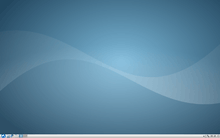
Lubuntu 10.10 was released on schedule on 10 October 2010, the same day as Ubuntu 10.10 Maverick Meerkat, but it was not built with same underlying infrastructure as Ubuntu 10.10. Developer Julien Lavergne said about it, "Lubuntu is actually not part of the Ubuntu family, and not build [sic] with the current Ubuntu infrastructure. This release is considered as a «stable beta», a result that could be a final and stable release if we was [sic] included in the Ubuntu family." Version 10.10 introduced new artwork to the distribution, including new panel and menu backgrounds, a new Openbox theme, new Lubuntu menu logo, splash images and desktop wallpaper. Lubuntu 10.10 was not accepted as an official Ubuntu derivative at this release point due to "a lack of integration with the infrastructure Canonical and Ubuntu" but work is continuing towards that goal.[39][40][41]
Lubuntu 10.10 was only released as a 32-bit ISO file, but users could install a 64-bit version through the 64-bit Mini ISO and then install the required packages.[30][31]
Developer Julien Lavergne wrote that while 10.10 incorporated many changes over 10.04, not all of the changes were considered improvements. The improvements included a new theme designed by Rafael Laguna, the incorporation of xpad for note taking, Ace-of-Penguins games, LXTask the LXDE task manager in place of the Xfce application, replacing the epdfview PDF reader with Evince, due to a memory leak problem, and removing pyneighborhood. The minuses included a last minute re-write of the installer to integrate it properly, which resulted in some installation instability and the raising of the minimum installation RAM from 180 MB to 256 MB. The other issue was the incorporation of the Ubuntu Update Manager which increased RAM usage by 10 MB. Lubuntu 10.04 had no indication of updates being available, so this was deemed necessary.[42][43]
The minimum system requirements for Lubuntu 10.10 were described by Mario Behling as "comparable to Pentium II or Celeron systems with a 128 MB RAM configuration, which may yield a slow yet usable system with lubuntu."[37] Chief developer Julien Lavergne stated that the minimum RAM to install Lubuntu 10.10 is 256 MB.[42]
In reviewing Lubuntu 10.10 right after its release in October 2010, Jim Lynch of Eye On Linux said "Lubuntu’s biggest appeal for me is its speed; and it’s no disappointment in that area. Applications load and open quickly, and my overall experience with Lubuntu was quite positive. I detected no stability problems, Lubuntu 10.10 was quite solid and reliable the entire time I used it." Lynch did fault the choice of Synaptic as the package manager: "One of the strange things about Lubuntu is that it only offers Synaptic as its package manager. Xubuntu 10.10, on the other hand, offers the Ubuntu Software Center as well as Synaptic. I’m not sure why the Ubuntu Software Center is missing from Lubuntu; it would make a lot of sense to include it since it is a much easier and more attractive way to manage software. Synaptic gets the job done, but it’s less friendly to new users and can’t match the Ubuntu Software Center in terms of usability and comfort."[44]
By mid-December 2010 Lubuntu had risen to 11th place on DistroWatch's six month list of most popular Linux distributions out of 319 distributions, right behind Puppy Linux and well ahead of Xubuntu which was in 36th place.[45] In reviewing Linux distribution rankings for DistroWatch in early January 2011 for the year 2010 versus 2009, Ladislav Bodnár noted, "Looking through the tables, an interesting thing is the rise of distributions that use the lightweight, but full-featured LXDE desktop or the Openbox window manager. As an example, Lubuntu now comfortably beats Kubuntu in terms of page hits..."[46]
Lubuntu 11.04
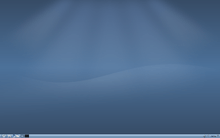
The project announced the development schedule in November 2010 and Lubuntu 11.04 was released on time on 28 April 2011.[47][48][49][50]
Lubuntu 11.04 was only released as a 32-bit ISO file, but users could install a 64-bit version through the 64-bit Mini ISO and then install the required packages. An unofficial 64-bit ISO of 11.04 was also released by Kendall Weaver of Peppermint OS.[30][31][51]
Improvements in Lubuntu 11.04 included replacing Aqualung with Audacious as the default music player, elimination of the hardware abstraction layer, introducing movable desktop icons, Ubuntu font by default, improved menu translations and reorganized menus. The release also introduced a new default theme and artwork designed by Raphael Laguna, known as Ozone, which is partly based on Xubuntu’s default Bluebird theme.[52][53][54]
Lubuntu 11.04 can be run with as little as 128 MB of RAM, but requires 256 MB of RAM to install from the graphics installer.[32]
While Lubuntu 11.04 had not completed the process for official status as a member of the Ubuntu family, Mario Behling stated: "The next goals of the project are clear. Apart from constantly improving the distribution, the lubuntu project aims to become an official flavour of Ubuntu."[55]
Mark Shuttleworth remarked to the Lubuntu developers upon the release of 11.04:
| “ | Thanks for the great work and progress of Lubuntu in the past 2 years. The fact that you are now 100% in the archive, and using PPA's and other tools effectively, makes it possible for us to consider recognising Lubuntu as an official part of the project. ... From my perspective, I see no problem in providing Lubuntu with the means to book sessions at UDS [Ubuntu Developer Summit], and for us to call attention to Lubuntu in the project release notes. ... Our goal with Ubuntu is to ensure that the archive contains the full richness of free software. LXDE is definitely part of that, and with the other desktop environments making greater demands on PC resources, LXDE has a continued role to play.[55] | ” |
In reviewing Lubuntu 11.04 just after its release, Joey Sneddon of OMG Ubuntu commented on its look: "Lubuntu’s 'traditional' interface will be of comfort to those agitated by the interface revolution heralded in GNOME 3 and Ubuntu Unity; it certainly won’t appeal to 'bling' fans! But that’s not to say attention hasn’t been paid to the appearance. The new default theme by Raphael Laguna and the use of the Ubuntu font helps to give the sometimes-basic-feeling OS a distinctly professional look." On the subject of official status Sneddon said, "Lubuntu has long sought official sanction from the Ubuntu Project family to be classed as an official 'derivative' of Ubuntu, earning a place alongside Kubuntu and Xubuntu. With such an accomplished release as Lubuntu 11.04 the hold out on acceptance remains disappointing if expected."[56]
In a review on 12 May 2011 Jim Lynch of Desktop Linux Reviews faulted 11.04 for not using the Ubuntu Software Center, the lack of alternative wallpapers and the use of AbiWord in place of LibreOffice. He did praise Lubuntu, "speed is one of the nice things about Lubuntu; even on a slow or older system it’s usually quite fast. It’s amazing what you can achieve when you cut out the unnecessary eye-candy and bloat."[57]
Also on 12 May 2011 Koen Vervloesem writing in Linux User & Developer criticized the applications bundled with Lubuntu, saying "Some of the software choices are rather odd, however. For instance, Chromium is the default web browser, which is a sensible move for a distro aimed at low-end computers, but the developers also ship Firefox, so Lubuntu shows both web browsers in the Internet menu. Also, the default screenshot program is scrot, but this is a command-line program and it is not shown in the Accessories menu, so not everyone will find it. Another odd choice is that you install your applications with Synaptic: by default Lubuntu doesn’t have the Ubuntu Software Center, which has been the preferred software installation program in Ubuntu for a good few releases now. These are just minor inconveniences, though, since you get access to the full Ubuntu software repositories, meaning you can install your favourite applications in a blink of the eye."[58]
One month after its release Lubuntu 11.04 had risen to ninth place on the DistroWatch 30-day list of most popular distributions.[59]
Lubuntu 11.10
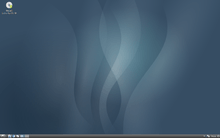
Lubuntu 11.10 was the first version of Lubuntu with official sanction as a member of the Ubuntu family. As part of this status change Lubuntu 11.10 used the latest Ubuntu infrastructure and the ISO files were hosted by Ubuntu. The release did not include many new features as work focused on integration with Ubuntu instead.[10][11][12][60]
11.10 was released on 13 October 2011, the same day that Ubuntu 11.10 was released.[61]
In September 2011 it was announced that work on a Lubuntu Software Center was progressing. The Ubuntu Software Center is too resource intensive for Lubuntu and so Lubuntu has been using the less user-friendly Synaptic package manager in recent releases. The development of a new lightweight application manager for Lubuntu is intended to rectify this problem, although users can, of course, install the Ubuntu Software Center using Synaptic.[62]
Changes in Lubuntu 11.10 include that it was built with the Ubuntu official build system using the current packages by default, alternative install and 64-bit ISOs were provided, use of xfce4-power-manager, a new microblog client, pidgin-microblog and a new theme by Rafael Laguna.[60][63]
Lubuntu 11.10 requires a minimum of 128 MB of RAM to run and 256 MB of RAM to install with the graphic installer. The recommended minimum RAM to run a live CD session is 384 MB.[64]
The Lubuntu 11.10 ISO file contains a known issue that causes it to fail to load a live CD session on some hardware, instead loading to a command prompt. Users are required to enter sudo start lxdm at the prompt to run the live CD session.[64]
In a review of Lubuntu 11.10 on PC Mech, writer Rich Menga described it as "simple, rock-solid, reliable, trustworthy". He added "Ubuntu at this point is suffering from major bloat on the interface side of things, and you can even say that about Xubuntu at this point – but not Lubuntu, as it gets back to what a great Linux distro should be."[65]
By the end of October 2011 Lubuntu had risen to seventh place on the DistroWatch one month popularity list.[66]
In a review in Linux User and Developer in November 2011, Russell Barnes praised Lubuntu 11.10 for its low system hardware requirements, for providing an alternative to GNOME and KDE, saying that its "aesthetic appeal and functionality is minimally compromised in its effort to be as sleek and light as possible". Barnes noted that Mark Shuttleworth may have been wise to offer full status to Lubuntu for this release given the "fuss and bluster surrounding Unity". Of the aesthetics he stated "the now trademark pale blue of the desktop is almost hypnotic. It’s incredibly clean, clear and logically laid out – a user experience a million miles away from that of Ubuntu 11.10’s Unity or GNOME Shell counterparts. In comparison there’s an almost cleansing nature about its simplicity." Barnes rated it as 4/5 and concluded "While it’s not as flexible or pretty as [GNOME 2], Lubuntu 11.10 has certainly got everything you need to keep your computer happy and your desktop clean and clutter-free"[67]
Igor Ljubuncic in Dedoimedo said about Lubuntu 11.10, "Lubuntu is meant to offer a valid alternative to the heavier KDE and Unity flavors. It tries bravely and fails heroically. The only advantage is the somewhat reduced system resource usage, but it is more than triply negatively compensated by the drawbacks of the desktop environment as well as the incomplete integration. Then, there you have Samba-related crashes, no laptop hotkeys, jumbled system tray icons, low battery life. If you want to be really mean, you could add the lack of customization, an average software arsenal, and a dozen other smaller things that get in the way... All in all, Lubuntu could work for you, but it's not exciting or spectacular in any way and packages a handsome bag of problems that you can easily avoid by using the main release... I would not recommend this edition... Grade: 6/10."[68]
Lubuntu 12.04
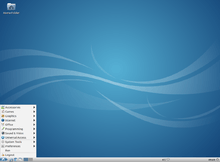
Lubuntu 12.04 was released on 26 April 2012.[69] Planning for this release took place at the Ubuntu Developer Summit held in early November 2011. Changes planned at that time for the release include the use of LightDM as the X display manager and Blueman instead of gnome-bluetooth for managing bluetooth devices.[70]
The Lubuntu Software Center was added with this release to provide a more user-friendly graphical interface for managing applications. Synaptic package manager is still installed by default and allows users manage all packages in the system and GDebi allows the installation of downloaded .deb packages.[70]
Lubuntu 12.04 was released with the Linux v3.2.14 Linux kernel and also introduced a large number of bug fixes, particularly in the LX panel and the PCManFM file manager. Also the Ubuntu Backports repository was enabled by default, meaning backport packages were not installed by default, but once installed were automatically upgraded to newer versions.[71][72]
Lubuntu 12.10
Lubuntu 12.10 was released on 18 October 2012 and includes a new version of the session manager, with more customization and integration options. It also includes a new version of the PCMan File Manager, with external thumbnail support. This version has new artwork, including a new wallpaper, a new icon set entitled Box and adjusted GTK themes. The notification-daemon has been replaced by xfce4-notifyd on the default installation. Previous versions of Lubuntu did not have a GUI search function and so the Catfish search utility was added to the default installation.[73][74][75][76]
This version of Lubuntu uses the Linux kernel 3.5.5, Python 3.2 and OpenJDK7 as the default Java implementation.[76]
The installation requires a CPU with Physical Address Extensions (PAE), which indicates an Intel Pentium Pro and newer CPU, except most 400 MHz-bus versions of the Pentium M. In the case of PowerPCs, it was tested on a PowerPC G4 running at 867 MHz with 640 MB RAM and will also run on all Intel-based Apple Macs.[76] There is also a version that supports the ARM architecture, but the developers currently only provide installation instructions for one ARM-based device (the Toshiba AC100 netbook).[77]
This release of Lubuntu does not support UEFI Secure Boot, unlike Ubuntu 12.10, which would have allowed it to run on hardware designed for Windows 8.[76] Lubuntu 12.10 could be run on UEFI secure boot hardware by turning off the secure boot feature.
Lubuntu 13.04

Lubuntu 13.04 was released on 25 April 2013.[78]
This version only incorporated some minor changes over Lubuntu 12.10, including a new version of the PCManFM file manager which incorporates a built-in search utility. Due to this particular file manager update, the Catfish search utility was no longer required and was deleted. Lubuntu 13.04 also introduced some artwork improvements, with new wallpaper offerings, new icons and a new installation slideshow.[79][80]
The minimum system requirements for Lubuntu 13.04 are a Pentium II or Celeron CPU with PAE support, 128 MB of RAM and at least 2 GB of hard-drive space. This release also still supports PowerPC architecture, requiring a G4 867 MHz processor and 640 MB of RAM minimum.[80]
Lubuntu 13.10
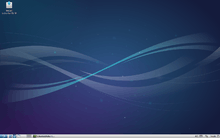
Julien Lavergne announced in June 2013 that Lubuntu 13.10 would ship with Firefox as its default browser in place of Chromium. This release also used LightDM for screen locking and included zRam.[81]
In reviewing the beta release in September 2013, Joey Sneddon of OMG Ubuntu said: "Lubuntu has never looked as good as it does in this latest beta." He noted that the new "box" icon theme had been expanded, progress bar colours softened and window controls enlarged along with a sharpened "start button".[82]
The final release incorporated only minor changes over 13.04. It included a new version of PCManFM that includes a file search function, which allowed the Catfish desktop search to be removed. There was also new artwork included and bug fixes for gnome-mplayer and the gpicview image viewer.[83]
In reviewing Lubuntu 13.10, Jim Lynch said "Sometimes less can be much, much more when it comes to Linux distributions. Lubuntu 13.10 offers some of the advantages of Ubuntu but in a much more minimalist package."[84]
Lubuntu 14.04 LTS

Tentative plans were announced in April 2013 to make Lubuntu 14.04 a long term support release.[85] In November 2013 it was confirmed that 14.04 would be the first Lubuntu LTS release with three years[86] of support. This release also saw xscreensaver replaced by light-locker screen lock.[87]
Released on 17 April 2014, Lubuntu 14.04 included just minor updates over version 13.10, along with a more featured file manager.[88]
Download media for Lubuntu 14.04 is available in PC 32 bit, PC 64 bit, Mac Intel 64 bit and Mac PowerPC. For early Intel Macs with a 32 bit Core solo processor, a 32-bit PC image is available.[89]
In reviewing Lubuntu 14.04 LTS Silviu Stahie of Softpedia noted, "because it uses a similar layout with the one found on the old and defunct Windows XP, this OS is considered to be a very good and appropriate replacement for Microsoft's operating system."[90]
On 1 June 2014 Jim Lynch reviewed Lubuntu 14.04 LTS and concluded, "Lubuntu 14.04 LTS performed very well for me. It was fast and quite stable while I was using it. I had no problems running any applications and the system as a whole lived up to its reputation as a great choice for Ubuntu minimalists... The LXDE desktop environment is very different than Unity for Ubuntu or GNOME 3 in Ubuntu GNOME. It’s a traditional desktop which means it’s very quick and easy to learn how to use. And if you are someone that doesn’t like Unity or GNOME then LXDE in Lubuntu 14.04 LTS might be just what the doctor ordered. You’ll get all the benefits of Ubuntu, but without the discomfort of the Unity interface."[91]
Lubuntu 14.10
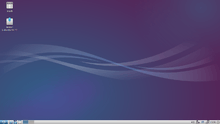
This release, on 23 October 2014, was originally intended to feature a version of LXDE based upon the Qt toolkit and called LXQt, but development of the latter was delayed and the feature was not implemented in time.[21][87]
Lubuntu 14.10 incorporated general bug fixes in preparation for the implementation of LXQt, updated LXDE components and new artwork, including more icons and a theme update.[92]
Silviu Stahie, writing for Softpedia stated, "One of the main characteristics of Lubuntu is the fact that it's fast, even on older computers. Basically, Lubuntu is able to run on anything built in the last decade, and there are very few operating systems out there that can claim the same thing... Just like its Ubuntu base, Lubuntu 14.10 has seen very few important visual modifications, although many packages have been updated under the hood. The theme and the icons have been updated, but the developers are preparing to make the switch to LXQt, a project that is still in the works."[93]
Igor Ljubuncic in Dedoimedo said about Lubuntu 14.10, "There's nothing functionally wrong with Lubuntu. It's not bad. It's simply not interesting. It's meat without flavor, it's a hybrid car, it's accounting lessons at the local evening school, it's morning news, it's a visit to Pompei while blindfolded. There's no excitement... I liked this desktop environment in the past, but it's stagnated. It hasn't evolved at all, and its competitors have left it far behind. And that reflects poorly on Lubuntu, which, despite a calm and stable record of spartan behavior, has left with me an absolute zero of emotional attachment toward it."[94]
Lubuntu 15.04

Released on 23 April 2015, Lubuntu 15.04 consisted primarily of bug fixes, as the project prepared for the planned switch to LXQt in Lubuntu 15.10. The Lubuntu Box theme was updated and merged into the Ubuntu Light theme to incorporate the most recent GTK+ features, including new header bars for Gnome native applications, plus improved artwork and icons.[95][96][97][98]
The minimum system requirements for this release include: 512 MB of RAM, with 1 GB recommended, plus a Pentium 4 or Pentium M or AMD K8 processor. The release notes indicated about graphics cards: "Nvidia, AMD/ATI/Radeon and Intel work out of the box".[98]
Marius Nestor of Softpedia noted, "...the Lubuntu 15.04 operating system comes now with updated artwork, which includes an updated theme, more beautiful icons, and an updated GTK+ infrastructure for better compatibility with Qt applications."[99]
Lubuntu 15.10

Released on 22 October 2015, Lubuntu 15.10 was originally planned to move to LXQt and its Qt libraries in place of the GTK+ libraries used by LXDE, but in June 2015 this was delayed to a future release. The release ended up as a minor bug fix and application version update.[100][101][102][103][104][105]
Changes in this versions included new artwork, iBus replaced by Fcitx, allowing fonts for Chinese, Japanese and Korean to be included. lubuntu-extra-sessions is now optional instead of default.[106]
The minimum system requirements for this release stated, "For advanced internet services like Google+, Youtube, Google Docs and Facebook, your computer needs about 1 GB RAM. For local programs like Libre Office and simple browsing habits, your computer needs about 512 MB RAM ... The minimum specification for CPU is Pentium 4 or Pentium M or AMD K8. Older processors are too slow and AMD K7 has problems with flash video ... Nvidia, AMD/ATI/Radeon and Intel work out of the box, or the system can be tweaked to work fairly easily.[104]
Joey Sneddon of OMG Ubuntu humourously noted, "Lubuntu 15.10 is another highly minor bug fix release."[107]
Lubuntu 16.04 LTS
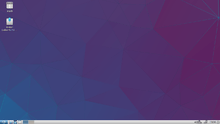
Released on 21 April 2016, Lubuntu 16.04 is a Long Term Support (LTS) version, supported for three years until April 2019. It is the second Lubuntu LTS version, preceded by 14.04 in April 2014.[108]
This release retains the LXDE desktop and did not make the transition to LXQt, to allow LXQt to be better tested in later non-LTS releases.[109][110]
This release is too large a file to fit on a CD and requires a DVD or USB flash drive installation. Lubuntu 16.04 LTS is primarily a bug-fix release and includes few new features. It does have updated artwork, however. The system requirements include 512 MB of RAM (1 GB recommended) and a Pentium 4, Pentium M, AMD K8 or newer CPU.[111][112]
The first point release, 16.04.1, was released on 21 July 2016. Lubuntu 16.04.2 will be released on 19 January 2017.[108]
Lubuntu 16.10
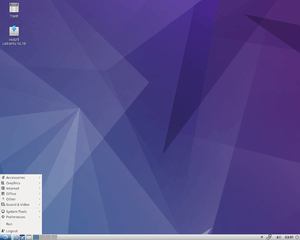
Lubuntu 16.10 was released on 13 October 2016.[113] It uses LXDE and not LXQt.[114] The implementation of LXQt has been delayed until 17.04.[115]
The release also features just small bug fixes, updated LXDE components and updated artwork, particularly the wallpaper.[115]
The developers recommended system requirements for this release were, "for advanced internet services like Google+, YouTube, Google Drive, and Facebook, your computer needs at least 1 GB of RAM. For local programs like LibreOffice and simple browsing habits, your computer needs at least 512 MB of RAM. The minimum specification for CPU is Pentium 4 or Pentium M or AMD K8. Older processors are too slow and the AMD K7 has problems with Flash video."[115]
Joey Sneddon of OMG Ubuntu noted that there are very few new features in Lubuntu 16.10, but that it no longer uses the Lubuntu Software Centre, having switched to GNOME Software, as Ubuntu has, also. Sneddon wrote, "Lubuntu 16.10 is largely the same as Lubuntu 16.04 LTS as work on switching to the LXQt desktop — expected next release — continues."[116] In a July 2016 article Sneddon singled out the new wallpaper design for Lubuntu 16.10, saying, "the jaggedy geometric layout of the new backdrop stands out as one of the more visually distinct to ship in recent years".[117]
Marius Nestor of Softpedia, wrote, "it appears that there are a lot of known issues for this release, so if you're using Lubuntu 16.04 LTS (Xenial Xerus), we don't recommend upgrading to Lubuntu 16.10, or at least read about them before attempting an upgrade operation."[118]
Applications
Lubuntu includes the following applications:[119]
|
|
Lubuntu also has access to the Ubuntu software repositories through the Lubuntu Software Center, the Synaptic package manager and APT allowing the installation of any applications available to Ubuntu.
Releases
| Legend: | Old version | Older version, still supported | Current stable version | Future release |
|---|
| Version | Code name | Release date | Supported until | Remarks |
|---|---|---|---|---|
| 8.10 | Intrepid Ibex | 2008-10-30 | April 2010 | Available as an optional desktop package only[13] |
| 9.04 | Jaunty Jackalope | 2009-04-23 | October 2010 | Available as an optional desktop package only[13] |
| 9.10 | Karmic Koala | 2009-10-26 | April 2011 | Available as an optional desktop package only[15] |
| 10.04 | Lucid Lynx | 2010-05-02[25] | April 2013 | First stand-alone version, supported as if it were an LTS to provide longer term support for old CPUs[24][32] |
| 10.10 | Maverick Meerkat | 2010-10-10 | April 2012 | Considered to be a "stable beta"[39] |
| 11.04 | Natty Narwhal | 2011-04-28[47] | October 2012 | |
| 11.10 | Oneiric Ocelot | 2011-10-13 | April 2013 | First version with an official x86-64 live CD. First version with official sanction as a member of the Ubuntu family.[10] |
| 12.04 | Precise Pangolin | 2012-04-26 | October 2013 | Ubuntu 12.04 is a long term support release, but Lubuntu 12.04 is not. |
| 12.10 | Quantal Quetzal | 2012-10-18 | April 2014 | Includes new Box Icon Theme |
| 13.04 | Raring Ringtail | 2013-04-25 | December 2013 | |
| 13.10 | Saucy Salamander | 2013-10-17 | June 2014 | Chromium replaced with Firefox |
| 14.04 LTS | Trusty Tahr | 2014-04-17 | April 2017 | First Lubuntu long-term support release, supported for 3 years |
| 14.10 | Utopic Unicorn | 2014-10-24 | June 2015 | |
| 15.04 | Vivid Vervet | 2015-04-23 | December 2015 | |
| 15.10 | Wily Werewolf | 2015-10-22 | 28 July 2016[120] | |
| 16.04 LTS | Xenial Xerus | 2016-04-21[108] | April 2019 | Second Lubuntu long-term support release, supported for 3 years |
| 16.10 | Yakkety Yak | 2016-10-13 | July 2017 | Current version |
| 17.04 | Zesty Zapus | April 2017 | December 2017 | Future version |
Timeline

See also
- Similar Linux distributions
- Linux Mint LXDE - a similar project based on Ubuntu and LXDE.
- Manjaro Linux - a similar project based on Arch Linux with various desktops to choose from, including LXDE.
- Peppermint OS - based on Lubuntu with Linux Mint's utilities.
- Other links
- Computer technology for developing areas
- Free culture movement
- Linux user group
- List of Ubuntu-based distributions
- Open-source software
- Ubuntu Certified Professional
References
- 1 2 Smart, Chris (May 2009). "Another day, another Ubuntu derivative.". Retrieved 21 May 2009.
- 1 2 3 LXDE (February 2009). "Lubuntu? LXDE Meet up with Mark Shuttleworth in Berlin". Retrieved 21 May 2009.
- 1 2 Canonical Ltd. (May 2009). "Lubuntu". Retrieved 24 May 2009.
- ↑ Lubuntu Project. "lubuntu lightweight, fast, easier". Retrieved 26 November 2015.
- ↑ DistroWatch (October 2010). "Lubuntu". Retrieved 30 December 2010.
- 1 2 Linux Magazine (September 2009). "Lubuntu". Retrieved 12 October 2009.
- ↑ Fosdick, Howard (February 2011). "Lubuntu: Finally, a Lightweight Ubuntu!". OS News. Retrieved 1 March 2011.
- ↑ LXDE Team (n.d.). "LXDE". Retrieved 26 October 2008.
- ↑ "About the Name". Official Ubuntu Documentation. Canonical Ltd. Retrieved 8 November 2010.
- 1 2 3 Sneddon, Joey (May 2011). "Lubuntu made 'official Ubuntu derivative'". OMG Ubuntu. Retrieved 11 May 2011.
- 1 2 Kissling, Kristian and Rikki Kite (May 2011). "Ubuntu Makes Lubuntu Official Derivative". Ubuntu User. Retrieved 15 May 2011.
- 1 2 Behling, Mario (May 2011). "lubuntu on track to official status as Ubuntu flavour". Retrieved 28 May 2011.
- 1 2 3 LXDE Wiki (November 2008). "Ubuntu". Retrieved 3 December 2008.
- ↑ TuxJournal.net (2009). "Interview with Mario Behling of LXDE page 1". Retrieved 21 July 2009.
- 1 2 Lavergne, Julien (October 2009). "Lubuntu 9.10 and plan for Lucid". Retrieved 2 May 2010.
- ↑ TuxJournal.net (2009). "Interview with Mario Behling of LXDE page 4". Retrieved 21 July 2009.
- ↑ Barbu, Doru (September 2009). "First Lubuntu Test ISOs Available". Softpedia. Retrieved 14 November 2010.
- ↑ Behling, Mario (March 2009). "Lubuntu". Retrieved 24 May 2009.
- ↑ Behling, Mario (August 2009). "First Lubuntu test ISO available". Retrieved 4 September 2009.
- ↑ DistroWatch (September 2009). "DistroWatch Weekly, Issue 319, 7 September 2009". Retrieved 8 September 2009.
- 1 2 Sneddon, Joey (6 June 2014). "Lubuntu 14.10 Unlikely To Ship LXQt Desktop By Default". OMG Ubuntu. Retrieved 6 June 2014.
- ↑ Stahie, Silviu (18 November 2014). "Lubuntu-LXQt 14.10 Is an Unofficial Evolution of Lubuntu – Screenshot Tour". Softpedia. Retrieved 15 December 2014.
- ↑ "Lenny". Ubuntu Wiki. Retrieved 15 August 2014.
- 1 2 Lavergne, Julien (December 2009). "Lubuntu Lucid Alpha 1 "Preview"". Retrieved 8 January 2010.
- 1 2 Behling, Mario (May 2010). "Lubuntu 10.04 is now available for download". Retrieved 15 October 2010.
- ↑ Behling, Mario (December 2010). "lubuntu Lucid Beta 1 released". Lubuntu Official Blog. Retrieved 31 December 2010.
- ↑ DistroWatch (January 2010). "Booting Ubuntu in 15 seconds, Lubuntu update, Slackware articles round-up, insecurity of OpenBSD, Qimo 4 Kids 2.0". Retrieved 25 January 2010.
- ↑ Lavergne, Julien (January 2010). "Lubuntu-desktop - Lubuntu Lucid Alpha 2 "Preview 2"". Retrieved 15 January 2010.
- 1 2 Sneddon, Joey (January 2010). "Lubuntu 10.04 Alpha 1 – Visual Overview". OMG Ubuntu. Retrieved 14 November 2010.
- 1 2 3 Canonical Ltd (December 2010). "Documentation Help". Retrieved 11 May 2011.
- 1 2 3 Canonical Ltd (May 2011). "Minimal Install". Retrieved 11 May 2011.
- 1 2 3 Lavergne, Julien (April 2011). "Natty Narwhal System Requirements". Retrieved 30 April 2011.
- ↑ Sneddon, Joey (October 2010). "Lubuntu 10.10 Released". OMG Ubuntu. Retrieved 5 December 2010.
- ↑ Oh, Damien (May 2010). "Lubuntu Review: A Lightweight Ubuntu Variant". Make Tech Easier. Retrieved 5 December 2010.
- ↑ Catling, Robin (October 2010). "Review - Lubuntu" (PDF). Full Circle magazine. Retrieved 30 December 2010.
- ↑ Lynch, Jim (June 2010). "Lubuntu 10.04". Desktop Linux Reviews. Retrieved 11 January 2011.
- 1 2 Behling, Mario (October 2010). "lubuntu 10.10 released". Retrieved 14 December 2010.
- ↑ OMG Ubuntu (September 2010). "Lubuntu fails to gain official Ubuntu spin status this cycle". Retrieved 4 September 2010.
- 1 2 Behling, Mario (October 2010). "Lubuntu 10.10 released". Retrieved 13 October 2010.
- ↑ Andrew (July 2010). "New Artwork For Lubuntu 10.10 Maverick Meerkat [Screenshots]". Web Upd8. Retrieved 14 October 2010.
- ↑ Tux Journal (September 2010). "Lubuntu 10.10 non farà parte della famiglia Canonical (Italian language)". Tux Journal. Retrieved 16 October 2010.
- 1 2 Lavergne, Julien (October 2010). "Lubuntu 10.10 is out". Retrieved 1 January 2011.
- ↑ Lavergne, Julien (October 2010). "Lubuntu-desktop Lubuntu 10.10 released". Retrieved 1 January 2011.
- ↑ Lynch, Jim (October 2010). "Quick Look: Lubuntu 10.10". Eye On Linux. Retrieved 10 December 2010.
- ↑ DistroWatch (December 2010). "Linux Distributions - Facts and Figures". Retrieved 14 December 2010.
- ↑ Bodnar, Ladislav (January 2011). "DistroWatch Page Hit Ranking statistics in 2009 and 2010". DistroWatch. Retrieved 4 January 2011.
- 1 2 Sneddon, Joey (November 2010). "Lubuntu 11.04 gets a release schedule". OMG Ubuntu. Retrieved 5 December 2010.
- ↑ Lavergne, Julien (April 2011). "Index of /~gilir". people.ubuntu. Retrieved 28 April 2011.
- ↑ Sneddon, Joey (February 2011). "Lubuntu 11.04 Alpha 2 to be delayed". OMG Ubuntu. Retrieved 16 February 2011.
- ↑ Sneddon, Joey (February 2011). "The second alpha release of Lubuntu 11.04 has been made available for testing". OMG Ubuntu. Retrieved 16 February 2011.
- ↑ Sneddon, Joey (May 2011). "Lubuntu 64bit image available for download". OMG Ubuntu. Retrieved 11 May 2011.
- ↑ Sneddon, Joey (February 2011). "Lubuntu's new theme 'ozone' ready for testing". [OMG Ubuntu. Retrieved 16 February 2011.
- ↑ Canonical Ltd (January 2011). "LubuntuArtworkIncomingNattyOzone". Kubuntu. Retrieved 16 February 2011.
- ↑ Behling, Mario (April 2011). "Lubuntu 11.04 released". Retrieved 30 April 2011.
- 1 2 Behling, Mario (April 2011). "Mark Shuttleworth says "Thank you" to lubuntu community". Retrieved 30 April 2011.
- ↑ Sneddon, Joey (April 2011). "Lubuntu 11.04 released; project on the way to official Ubuntu spin status". OMG Ubuntu. Retrieved 2 May 2011.
- ↑ Lynch, Jim (June 2011). "Lubuntu 11.04". Retrieved 6 June 2011.
- ↑ Vervloesem, Koen (May 2011). "Lubuntu 11.04 review – If it's good enough for Mark Shuttleworth…". Linux User & Developer. Retrieved 14 October 2011.
- ↑ DistroWatch (December 2010). "Linux Distributions - Facts and Figures". Retrieved 28 May 2011.
- 1 2 Lavergne, Julien (October 2011). "Lubuntu 11.10 released". Retrieved 14 October 2011.
- ↑ Sneddon, Joey (May 2011). "Lubuntu 11.10 release schedule". OMG! Ubuntu]. Retrieved 27 May 2011.
- ↑ Sneddon, Joey (September 2011). "Progress Continues On 'Lubuntu Software Center'; Here's How To Install It". OMG! Ubuntu!. Retrieved 9 September 2011.
- ↑ Lubuntu (October 2011). "11.10". Retrieved 13 October 2011.
- 1 2 Lubuntu (October 2011). "OneiricOcelot". Retrieved 14 October 2011.
- ↑ Menga, Rich (October 2011). "A Quick Look At Lubuntu 11.10 (Video)". PC Mech. Retrieved 14 October 2011.
- ↑ DistroWatch (October 2011). "Linux Distributions - Facts and Figures". Retrieved 14 October 2011.
- ↑ Barnes, Russell (16 November 2011). "Lubuntu 11.10 review – a cure to Ubuntu's Unity blues?". Linux User and Developer. Retrieved 20 November 2011.
- ↑ Ljubuncic, Igor (18 November 2011). "Lubuntu 11.10 review - Alternative to Unity?". Dedoimedo. Retrieved 9 May 2015.
- ↑ "12.04 is now available". lubuntu. Retrieved 29 July 2012.
- 1 2 "PrecisePangolin/ReleaseNotes/Lubuntu - Ubuntu Wiki". Wiki.ubuntu.com. Retrieved 29 July 2012.
- ↑ Canonical (26 April 2012). "New Features in Lubuntu 12.04". Retrieved 6 May 2012.
- ↑ Lubuntu Project (26 April 2012). "Lubuntu 12.04 released!". Retrieved 6 May 2012.
- ↑ "QuantalQuetzal/TechnicalOverview/Alpha3 - Ubuntu Wiki". Wiki.ubuntu.com. Retrieved 29 July 2012.
- ↑ "Lubuntu work items for Q : Blueprints : Ubuntu". Blueprints.launchpad.net. Retrieved 29 July 2012.
- ↑ Sneddon, Joey (3 August 2012). "New Icon Theme Lands in Lubuntu 12.10". OMG Ubuntu. Retrieved 10 August 2012.
- 1 2 3 4 Lubuntu (18 October 2012). "New Features in Lubuntu 12.10". Retrieved 18 October 2012.
- ↑ "ARM/TEGRA/AC100 - Ubuntu Wiki". Wiki.ubuntu.com. 2013-07-11. Retrieved 2013-07-21.
- ↑ "Lubuntu/Developers". Ubuntu wiki. Lubuntu. 2013-03-10. Retrieved 14 March 2013.
- ↑ "Lubuntu/Announcement/13.04 - Ubuntu Wiki". Wiki.ubuntu.com. Retrieved 2013-04-28.
- 1 2 Joey-Elijah Sneddon (2013-04-25). "Ubuntu Flavours Release 13.04 Updates". OMG! Ubuntu!. Retrieved 2013-05-06.
- ↑ Bhandari, Anurag (13 June 2013). "Lubuntu 13.10 To Have Firefox by Default, Disregard its Daddy". Muktware. Retrieved 23 June 2013.
- ↑ Joey-Elijah Sneddon. "Ubuntu 13.10 Beta Releases Available for Download". OMG! Ubuntu!. Retrieved 2013-09-06.
- ↑ "13.10 (Saucy Salamander) released". Lubuntu. Retrieved 18 October 2013.
- ↑ Lynch, Jim (20 October 2013). "Lubuntu 13.10". Linux Desktop Reviews. Retrieved 29 October 2013.
- ↑ "Roadmap for Lubuntu". Lists.ubuntu.com. Retrieved 2013-09-06.
- ↑ "TrustyTahr/ReleaseNotes - Ubuntu Wiki". ubuntu.com. Retrieved 24 April 2015.
- 1 2 Joey-Elijah Sneddon (2013-07-27). "What to Expect in Xubuntu 14.04 LTS and Lubuntu 14.04 LTS". OMG! Ubuntu!. Retrieved 2013-11-30.
- ↑ Sneddon, Joey (2 March 2014). "Ubuntu 14.04 Flavours Release First Beta". OMG Ubuntu. Retrieved 2 March 2014.
- ↑ "Lubuntu/GetLubuntu". ubuntu.com. Retrieved 24 April 2015.
- ↑ Stahie, Silviu (17 April 2014). "Lubuntu 14.04 LTS (Trusty Tahr) Has Been Released and Is Ready to Replace Windows XP". Softpedia. Retrieved 21 April 2014.
- ↑ Lynch, Jim (1 June 2014). "Lubuntu 14.04 LTS". Linux Desktop Reviews. Retrieved 2 June 2014.
- ↑ Behling, Mario (23 October 2014). "Lubuntu 14.10 Utopic Unicorn released". Lubuntu.net. Retrieved 24 October 2014.
- ↑ Stahie, Silviu (29 October 2014). "Lubuntu 14.10 (Utopic Unicorn) Is the Lightest Ubuntu Flavor". Softpedia. Retrieved 23 October 2014.
- ↑ Ljubuncic, Igor (18 March 2015). "Lubuntu 14.10 Utopic Unicorn - No, not really". Dedoimedo. Retrieved 9 May 2015.
- ↑ Sneddon, Joey (19 December 2014). "Ubuntu 15.04 Alpha 1 Releases Now Ready for Download". OMG Ubuntu. Retrieved 15 December 2014.
- ↑ Canonical Ltd (5 December 2014). "Vivid Vervet Release Schedule". Retrieved 19 December 2014.
- ↑ Laguna, Rafael (12 February 2015). "Ubuntu re-merge". Lubuntu Blog. Retrieved 15 February 2015.
- 1 2 "VividVervet/ReleaseNotes/Lubuntu - Ubuntu Wiki". ubuntu.com. Retrieved 24 April 2015.
- ↑ Nestor, Marius (23 April 2015). "Lubuntu 15.04 Is the Last Release to Use LXDE As the Team Prepares for LXQt - Screenshot Tour". Softpedia. Retrieved 28 April 2015.
- ↑ Marius Nestor (26 June 2015). "Lubuntu 15.10 Alpha 1 Is Still Using LXDE As LXQt Is in Development - Screenshot Tour". softpedia. Retrieved 10 July 2015.
- ↑ Joey-Elijah Sneddon. "Ubuntu 15.10 Alpha 1 Releases Now Ready for Download". OMG! Ubuntu!. Retrieved 11 July 2015.
- ↑ Marius Nestor (8 May 2015). "Lubuntu 15.10 (Wily Werewolf) to Finally Switch to LXQt". softpedia. Retrieved 9 May 2015.
- ↑ "WilyWerewolf/ReleaseSchedule - Ubuntu Wiki". ubuntu.com. Retrieved 24 May 2015.
- 1 2 "WilyWerewolf/ReleaseNotes/Lubuntu - Ubuntu Wiki". ubuntu.com. Retrieved 22 October 2015.
- ↑ Marius Nestor (23 October 2015). "Lubuntu 15.10 (Wily Werewolf) Out Now, Remains Based on the LXDE Desktop". softpedia. Retrieved 23 October 2015.
- ↑ "Lubuntu 15.10 Wily Werewolf released". lubuntu.net. Retrieved 25 October 2015.
- ↑ Joey-Elijah Sneddon. "Ubuntu 15.10 Flavors Now Available for Download". OMG! Ubuntu!. Retrieved 26 October 2015.
- 1 2 3 "XenialXerus/ReleaseSchedule - Ubuntu Wiki". ubuntu.com. Retrieved 23 October 2015.
- ↑ "Lubuntu 16.04 Is Sticking To GTK2-Based LXDE Rather Than LXQt - Phoronix". phoronix.com. Retrieved 5 January 2016.
- ↑ Marius Nestor (4 January 2016). "Lubuntu 16.04 LTS Alpha 1 (Xenial Xerus) Is GTK Based, Still No Sight of LXQt". softpedia. Retrieved 5 January 2016.
- ↑ "XenialXerus/ReleaseNotes/Lubuntu - Ubuntu Wiki". ubuntu.com. Retrieved 21 April 2016.
- ↑ "Lubuntu 16.04 Xenial Xerus LTS released". Lubuntu. Retrieved 22 April 2016.
- ↑ "YakketyYak/ReleaseSchedule". 22 April 2016. Retrieved 22 April 2016.
- ↑ "Lubuntu 16.10, Yakkety Yak". Ubuntu. Retrieved 13 August 2016.
- 1 2 3 "YakketyYak/ReleaseNotes/Lubuntu - Ubuntu Wiki". ubuntu.com. Retrieved 16 October 2016.
- ↑ "These Are The New Features in Ubuntu 16.10 Flavors". omgubuntu.co.uk. 13 October 2016. Retrieved 16 October 2016.
- ↑ "This is Lubuntu 16.10's New Default Wallpaper - OMG! Ubuntu!". omgubuntu.co.uk. 28 July 2016. Retrieved 16 October 2016.
- ↑ Nestor, Marius. "Lubuntu 16.10 Lands as a Bugfix Release That Prepares the Distro for LXQt". softpedia.com. Retrieved 16 October 2016.
- ↑ Lubuntu Project (11 October 2012). "Applications". Retrieved 3 November 2014.
- ↑ Nestor, Marius. "Ubuntu 15.10 (Wily Werewolf) to Reach End of Life on July 28, 2016". softpedia.com. Retrieved 7 July 2016.
External links
| Wikimedia Commons has media related to Lubuntu. |
- Official website
- Old Official website
- Lubuntu at DistroWatch
- Lubuntu Documentation
- Lubuntu - Ubuntu Wiki